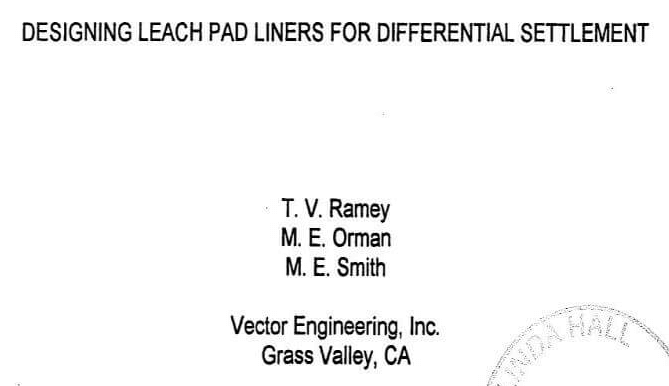Differential settlement of a leach pad liner is typically thought of being caused by consolidation of soils due to the load created by the heap materials over a soft clay soil and/or elastic compression of the subgrade soils due to this load. In these cases, the loads at the toe of the heap are essentially zero and they increase to some maximum at the crest or deepest part of the heap. The differing loads cause differential settlement. There are also other possible causes for settlement. The primary and possibly most damaging is the isolated (collapsing) settlement caused by the creation of voids within soils underlying the liner. These voids can be created by the presence of erosion of the soils and by dissolving (dissolution) of particles within the soil structure by leaked solutions. The result is the collapse of the overlying liner and heap into the void created. Most leaks are the result of small (less than ½ inch [1.27 cm] diameter) holes in the liner due to undetected seam defects or punctures. Because of the relatively strict quality control (QC) and quality assurance (QA) requirements demanded on most projects by the engineer, owner and regulatory agencies (Ref. 1, 5, 8), larger holes rarely go undetected. However, even if small holes are left unattended, as with beneath a heap, they can create large voids and differential settlement that can result in stresses in the geomembrane. These stresses can be greater than the strength of the synthetic material, thus, enlarging the hole or even tearing the liner and causing greater leakage. This effect can begin to snowball causing catastrophic failure.
The degree of erosion of the soil and dissolution of the salt particles beneath holes in the liner are controlled by many factors. These include the soil type (i.e. clay, silt, sand, or gravel), soluble salt content of the soil, solution type, density of the soil, depth of solution (head) over the liner, degree of contact (gap) between the geomembrane and the underlying soil, type and thickness of the geomembrane, and shape and size of the hole. Many of these factors have been discussed in previous studies (Ref. 1, 2, 5, 8). Erosion of soil beneath holes in geomembranes was specifically addressed in a report for the USEPA prepared by Brown and others (Ref.2). In that report, they developed a model calculation procedure to predict conditions for initiation of erosion in soils beneath holes of various sizes in geomembrane liners. Although this model addressed the conditions which may lead to erosion, they did not deal with the ramifications (i.e. differential settlement stresses in the liner and the resulting increased leakage rate because of an increased hole diameter or tear). The tests performed and subsequent model were developed under high head conditions of approximately 10 meters (33 feet). They did state, however, that, “Erosion of the soil subbase could result in catastrophic failure if the support for the liner is lost. Thus, further research on the factors influencing and methods of curtailing such erosion should be undertaken.” They went on to conclude that “erosion of the soil subbase can occur immediately below a flaw in a FML (flexible membrane liner), particularly when the head is large, as would occur in a lagoon, and when the conductivity of the subbase soil is greater that 10 -6 cm s -1.”
Brown and others, (Ref. 2) performed other tests to evaluate leakage form holes in geomembranes,; however, they did not mention the occurrence of erosion of the soil subbase under lower heads in their description of the post-test conditions. The solution collection systems for leach pads are typically designed to keep the hydraulic head over the liner to less than one meter (3.3 feet). The overburden pressures for a heap leach pad are very high due to the ore placement; therefore, there is generally intimate contact of the pad liner with the subbase. This condition will likely minimize any erosion that would occur under the lower head conditions (at least in the initial stages of leakage).

